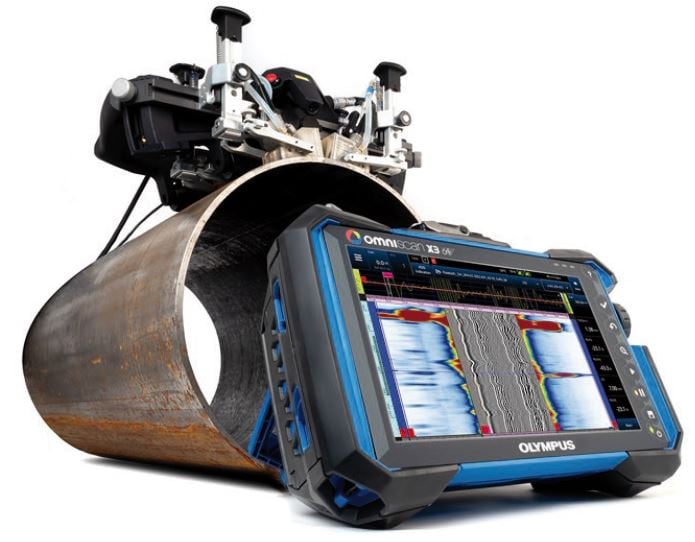A Four-Step Approach to Achieving Digital Transformation
ASME Pressure Vessels Without PRDs – Is That Allowed?
Damage Control: Brittle Fracture Assessment
FFS Forum: Miner’s Rule – A Primer on Linear Damage Accumulation
How Digital Technology Enhances Reliability Centered Maintenance
Implementation of a PDCA Process for In-Line Inspection of Pipelines
Using Data to Drive Your Turnaround Planning Strategy
A Fitness-for-Service Assessment of Thermal Dehydrators in NGL Plants – Fatigue Life Extension
A Hybrid Approach for Effective CUI Management
Damage Control: Brittle Fracture Detection
Don’t Throw Out Your IDMS Data: Use Statistics to Rebuild Trust
FFS Forum: Crack-like Flaw Categorization Rules
Improving Pipeline Integrity with Artificial Intelligence
Linking IOWs to RBI – Staying Evergreen
NDE Methods for Detecting In-Service FRP Damage
Solving the Mechanical Integrity and Reliability Program Sustainability Puzzle
Texas Storage Tank Owners Be Advised: SB 900 is Now in Effect
A Data-Driven Approach to Sustaining and Improving Your Mechanical Integrity Program
Automated Radiographic Testing: High-Speed Corrosion Mapping Using Robotic Crawlers
Damage Control: Sulfidation and High-Temperature H2/H2S Corrosion Mitigation
Damage Management Locations (DMLs) – Connecting Inspection Data with Asset Lifecycle Management
FFS Forum: The New API 579 Part 15, Piping Vibration – Interview with Lyle Breaux, Team Lead
Leveraging RBI and Corrosion Management Programs
MI Capability and Competency Development
The Ten Foundational Management Systems Needed to Achieve FEMI Operational Excellence
Advanced Microwave Inspection: Evolution of the Method
API 579 FFS Assessments of Storage Tanks with Uneven Support
ASME PCC-1: The Change from a Bolting Guideline to a Bolting Standard
Damage Control: Sulfidation and High-Temperature H2/H2S Corrosion Assessment
FFS Forum: Old Vessels vs New NDE
Lack of Fusion on Socket Weld Joints – A Case Study
The Three Types of FEMI Decision-Makers - Which One Are You?
Damage Control: Sulfidation and High-Temperature H2/H2S Corrosion Detection
FCCU Reliability Challenges Now and in the Future
FFS Forum: Local Thin Areas (LTAs) - How Bad is Too Bad?
Good Data/Bad Data for FFS Assessments
Quantifying the Value of Your Inspections
The Emergence and Development of Phased Array Ultrasonic Testing Techniques
Worst-to-First in FEMI Performance – How One Site is Making it Happen
Damage Control: High-Temperature Creep Mitigation
Data Validation: Are We Data-Rich, but Information-Poor?
FFS Forum: The Master Curve Approach to Estimating Fracture Toughness
Innovations in Data Analytics: Lessons from the World of Sports
Maximize the Value of RBI Program Implementation
Understanding Microbial Corrosion – Part 2: Microbial Corrosion Mitigation
2023 Inspectioneering Journal Article Index
This article features a discussion of three of the key elements to sustain and improve your mechanical integrity program successfully.
Failure of internal attachment welds became a chronic issue for an NGL plant. Identifying design discrepancies was key to eliminating repeated failures.
This article outlines a 4-step strategy for digital transformation in operations, aiming to enhance efficiency and maintenance practices.
A case study of insulation-drying technology that reduces the wetness time of thermal insulation and pipes.
The latest developments in microwave inspection of complex composites are summarized, including principles of multi-frequency microwave inspection.
This article describes a storage tank built in a permafrost area and how FFS and FEA were used to address the challenges of foundation instability.
Bolted joints are very complex, with many variables. This is a look at how ASME PCC-1 changed from a guideline to a standard with no precedence in doing so.
Not all operators apply the system design philosophy as intended by the ASME Code. Part of this reason could be due to confusion about how it is to be applied.
The capabilities of automated radiographic testing (ART) make it the preferred method to manual techniques for detecting piping corrosion defects in the field.
Part 2 of this three-part series on brittle fracture focuses on methods for evaluating the risk in pressure equipment and the evolution of screening and assessment methods.
This article is Part 1 of a new three-part series on brittle fracture and focuses on the fundamental concepts and damage morphology associated with the unstable rupture of pressure equipment.
Part 3 of this series provides pragmatic strategies for mitigating high-temperature creep damage in typical pressure component alloys.
This installment of Damage Control outlines the FFS methods available to analysts for evaluating wall loss such as sulfidation or high-temperature H2/H2S corrosion in pressure equipment
Comprehension of the sulfidation corrosion reaction and the behavior of different materials in H2-free and H2/H2S environments is imperative for oil refineries.
Part 3 of this series focuses on practical damage mitigation and life cycle management techniques to avoid failures and corrosion in refinery pressure equipment.
Introducing the concept of damage management locations, together with remaining life estimates from CML data, offers a complete view for inspection planning.
The focus of the 10th "Meeting of the Minds” roundtable discussion was on data validation and the importance of having consistent definitions of “good data.”
A discussion of common data challenges and how facilities can leverage data science and statistics to identify and potentially correct suspicious data.
A comparative analysis of robotic nondestructive inspection tools used to locate floor defects in aboveground storage tanks.
A look at common reliability issues to help give perspective on where issues may be waiting and how to handle them when they arise.
Real-world cracks don’t often resemble the idealized cracks on which fracture mechanics solutions are based. This is when categorization rules come into play.
Local thin area (LTA) assessments rarely fail. It happens, but not often. Let’s look at examples of how significant an LTA can be and still pass an assessment.
Miner’s rule remains the most used fatigue damage accumulation approach in the oil and gas industry.
A discussion on the rationale for being cautious with an inspection of older vessels and how to decide when such inspection is appropriate.
Ferritic materials change in toughness as a function of temperature, but the change is non-linear and happens at different temperatures for different materials.
The API 579 Committee has been steadily working for 10 years on a procedure to evaluate vibration in piping systems. That long work is about to pay off.
Common pitfalls in gathering inspection data using a case study where additional data gathering resulted in a significant improvement in FFS results.
With the latest digital and predictive technologies made possible by IIoT, the principles of reliability-centered maintenance have become easier to implement.
IIOT has revolutionized predictive management by introducing advanced technologies that can heighten the efficacy of corrosion management systems.
Recognizing how the phases of the PDCA cycle fit the particularities of ILI. Each stage is addressed to increase efficiency and safety in pipeline inspection.
With class-leading thermal performance, superior CUI defense, and complimentary engineering support, our aerogel insulation solutions are a top choice in helping facilities drive energy efficiency, improve safety, increase yields, and reduce downtime
Now adapted for pipeline inspections, machine learning technology is being used in the field to predict material loss and uncertainty.
The OmniScan™ X3 64 phased array and TFM flaw detector is equipped with enhanced phased capabilities and even faster TFM. The rugged and portable instrument features powerful 64-element probes with a 128-aperture TFM.
Can our industry learn a lesson from baseball's data-driven approach to move us into the next evolution of data analysis?
A look into how complications due to low diameter, geometry, procedure, and qualification of welders resulted in flaws that were overlooked.
It is important to know what damage mechanisms to look for and where to look for them. We will review the link between damage mechanism assignments and RBI.
This article proposes a framework for consideration, based on experience, that helps practitioners in utilizing IOWs to enable a more effective, sustainable, and dynamic RBI program.
The author highlights the importance of logical planning, proper management, and continuous management support to ensure a successful and valuable RBI program.
Inspectioneering and Pinnacle co-hosted the 11th “Meeting of the Minds” roundtable discussion focused on organization capability and competency development.
A look at the dominant damage mechanisms experienced by FRP during service and several detection methods to identify inspection information for FFS assessment.
Explore how more advanced modeling addresses the challenges of quantifying uncertainty and probability of failure to drive valuable inspections.
Addressing the sustainability of MI initiatives, specifically integrated, systematic processes and programs like RBI, RCM, APM, and EAM programs.
A follow-up for storage tank owners now that SB 900 is in effect, including additional information and identifying implications of recent updates.
A look back to when phased array systems were first developed in the 1960s and how the uses and technology have evolved throughout the decades to present day.
This article summarizes, at a high level, what the sites have been able to accomplish by implementing what the author believes are FEMI's best practices.
A look at the three types of fixed equipment mechanical integrity (FEMI) decision-makers you can encounter, along with the differences in the effectiveness of each.
The specialized predictive techniques used in assessing the vibration behavior observed and recorded on a pre-flash column overhead piping system.
This article concludes the series on microbial-induced corrosion by demonstrating the importance of microbe mitigation through two case studies.
Undocumented pressure vessels without an ASME stamp or National Board registration are commonplace. Their potential risk and value are often poorly understood.
In this article, we’ll discuss the current challenges with turnaround planning and how data-driven modeling can help optimize scope, duration, and intervals.
Download Pinnacle's Economics of Reliability Report - Refining to see how reliability is affecting profitability.
This article discusses how in-line inspection (ILI) can detect corrosion under insulation (CUI) in pipelines, emphasizing thorough, safe examination.
A review of the plan one site put in place to upgrade their performance from the fourth quartile to the first quartile and keep it there.
































































